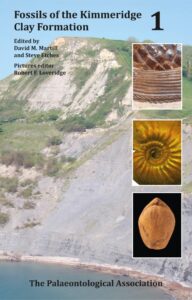Palaeontological Association Field Guide to Fossils No 16
Edited by David M Martill and Steve Etches (pictures editor, Robert F Loveridge)

I always wait expectantly for the publication of a new Palaeontological Association guide to fossils and, when they turn up, I am never disappointed. I have known about this one for quite some time, but I suspect COVID-19 got in the way – hence the long wait. However, this is another triumph.
And this should not be underestimated. The books are produced entirely by volunteer authors and editors, so new field guides are only published if people come forward with suitable proposals – and then follow them through without payment. I understand that the association has one proposal in the pipeline at the moment, but it is unlikely to be completed for a couple of years – as these things are done on top of full time jobs.
As for this guide, the Kimmeridge Clay formation straddles the Late Jurassic and lowermost Cretaceous. It is extremely rich in fossils and contains an astonishingly diverse assemblage of both invertebrate and vertebrate fossils. As a result, the guide is far from comprehensive, but it does attempt to bring the diversity of its flora and fauna together in a single work, for the first time. In fact, a specific aim of producing this guide is to provide future workers with a starting point for their own research into Kimmeridge Clay palaeontology and, at the same time, give fossil collectors (like me) a handy and informative aid to fossil identification. And that is why I love the PalAss guides.

Those of us who love the World Heritage Site of the ‘Jurassic Coast’ appreciate that the Upper Jurassic Kimmeridge Clay Formation of the UK is spectacularly exposed in the sea cliffs of its type locality in south Dorset. It is also seen intermittently through Wiltshire, the Home Counties, Norfolk, Lincolnshire and Yorkshire. In Scotland, deposits of the same age are seen on both the east coast and on the Isle of Skye. And, as I say above, the Kimmeridge Clay is highly fossiliferous, but the preservation of its fossils is also often exceptional. I have found ammonites with beautiful iridescence and other lucky souls have found articulated vertebrates, with stomach contents preserved.
In this respect, Fossils of the Kimmeridge Clay Formation is a comprehensive field guide, presented in two volumes, which reviews all of the major groups, from microfossils to dinosaurs, ichthyosaurs, plesiosaurs and pliosaurs. That is:
- Volume 1 explores the invertebrates, plants and trace fossils, as well giving a thorough introduction to the sedimentology and collecting from the formation. There is a substantial section on ammonites.
- Volume 2 is dedicated to vertebrate palaeontology.
Steve Etches MBE trained as a plumber, but is much better known as a fossil collector and preparator based in the eponymous village of Kimmeridge, on the Isle of Purbeck in Dorset. He has been collecting for over 30 years, during which he has amassed an important collection of rare and unique fossils (including ammonite eggs, among other things). The Etches Collection is a fossil museum in the village. It is based on Steve’s lifetime collection from the local area, especially around Kimmeridge Bay and the Kimmeridge Ledges. The museum was opened in 2016 to house a collection of over 2,000 fossil specimens.
Professor David Martill is a reader in palaeobiology, who works mainly on the palaeobiology of pterosaurs and exceptional preservation of fossil vertebrates. He is particularly interested in the Cretaceous, with projects on the dinosaurs of the Isle of Wight (see Dinosaurs of the Isle of Wight) and the palaeoecology of the Crato Formation, Brazil (see Fossils of the Santana and Crato Formations).
So, if you (like me) want Palass to keep publishing these wonderful guides to fossils, please continue to support it by buying this and the other guides. They will be investments well worth making.
Fossils of the Kimmeridge Clay Formation (volume 1), edited by David M Martill and Steve Etches, pictures editor Robert F Loveridge, the Palaeontological Association, London (2020), 436 pages (paperback), ISBN 978-0-901702-74-6
Fossils of the Kimmeridge Clay Formation, edited by David M Martill and Steve Etches, pictures editor Robert F Loveridge (volume 2), the Palaeontological Association, London (2020), 194 pages, (paperback), ISBN 978-0-901702-75-3


